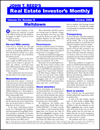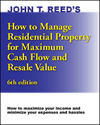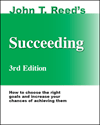John T. Reed's analysis of Richard Lindsey and Barry Schacter's book
How I Became a Quant


(This article first appeared in Real Estate Investor's Monthly.)
The comprehensive knowledge base of physics has inspired many another academic discipline to try to apply a physics-like framework to the analysis of those other fields. The book How I Became a Quant (short for quantitative finance advocate) tells how that has been attempted in finance. They try to apply a combination of probability, statistics, mathematics, computer science, and models that mimic those in physics to buy stocks. They even created an International Association of Financial Engineers.
The book reportedly stresses the point that physics and finance are only superficially similar and that financial models are always wrong, but not useless. I have often made a similar comment about the most highly regarded real estate models: internal rate of return or financial management rate of return.
I characterized them as useful for:
- teaching how real estate produces various types of returns over the long term
- comparing dissimilar, long-term, contractual streams of income or outgo
However, I said it would be extremely unwise to rely on them for their most common purpose: forecasting the overall, long-term performance of a rental property.
Two sentences in a pertinent Wall Street Journal article stand out.
Quants do get more respect these days, because their imperfect models can generate profits when used with knowledge of their limitations. But quants can also produce awe-inspiring disasters when they begin to idolize their man-made models.
I have recently been writing numerous articles on the limitations of our knowledge of markets and risk—our limitations. But I have added in those articles that the situation is somewhat like curing cancer. We do not know all or even much, but we do know some things that are useful. What is important is that we use what we know but simultaneously remain fully aware of and acknowledge the limitations of our expertise. JTR
(below is a second article with multiple references to How I Became a Quant by Richard Lindsey and Barry Schacter)
How you became a real estate investor
I just finished reading a book called How I Became a Quant. I previously read one called The First Time I Got Paid for It (by Hollywood writers).


The interesting thing seemed at first to be the two fields: financial arbitrage/market-movement forecasting/risk management and Hollywood writing. But I discovered something else: a common pattern by which people who are extremely well suited to their profession found their way into it.
Two-part article
This is intended to be part one of a two-part article. The second part will be stories told to me by readers about how they got into real estate and into their real estate strategies.
To stimulate discussion, I will use this part to explain how I got into real estate investment and how I evolved into the strategies I pursued and now advocate as a writer. For the same purpose, I will tell you how the successful quants got into their field.
Engineer
My first serious career plan arrived at in early high school was to become a chemical engineer. Why?
During World War II, my mom worked as a secretary in a shipyard that built Navy ships. She worked with architects and engineers. She had never met such people before and was quite impressed by them.
She decided, as did many of that “Greatest Generation,” that her kids would go to college. She wanted us to “make a living with our brains,” not “dig ditches.”
In addition, we rarely passed a bridge without my mom telling us, reverentially, that engineers did that.
Chemistry
Why a chemical engineer? I really liked chemistry. My parents got me a chemistry set and I supplemented it by buying additional equipment and chemicals with my allowance and paper route money.
Do I regret not going into chemical engineering? Nah. Very tough college major and you work for Exxon or BASF. Not a fit for me.
West Point
One day during the summer before my junior year of high school, my mom announced that we were going to visit my uncle who was assistant manager of the Hotel Thayer at West Point. Once there, I instantly fell in love with the idea of being a cadet.
Being a West Point cadet was about 100 times more glamorous and romantic in a Knights of the Round Table sense than anything I had ever imagined or done. I was far less excited about being an Army officer after West Point, but I figured it was what West Pointers do and I accepted it as part of the package.
Engineering
So what did I major in at West Point? Nothing. Not allowed. The things we studied most were math and engineering, including civil engineering, which included bridge design. I never thought of it when she was alive, but I should have told her how you design a bridge to close the loop that began for her at the shipyard. (Identify all the loads that will be placed on the bridge by wind, construction, traffic, snow, ice, etc.; add a safety margin; check the various steel components in the Steel Manual to see how much load each can carry; then find the design of adequate strength that costs the least.)


101st Airborne Division
Right in the middle of my four years at West Point, I did my standard, 30-day internship out in the “real Army.” I was sent to an artillery battalion in the 101st Airborne (paratroopers) Division at Fort Campbell, KY.
I was appalled. The “real Army” bore no resemblance to the one I thought I was joining when I entered West Point. Instead, it was an inept, Situation Normal All Fouled Up, corrupt, cynical, careerist (seeking personal advancement above all other values), ticket-punching, game-playing, sycophantic bureaucracy. Revulsion at bureaucracy was also a recurring theme in How I Became a Quant. One quant, Steve Allen, said of one of his early jobs: “Persuasion of other decision makers often hinged on internal political power.”
Within ten days of arriving at the 101st, I totally dropped my plan to be a career Army officer. Unfortunately, I had to spend six more years at West Point and in the Army including almost getting killed twice in Vietnam. Lesson: Don’t choose careers or employers based on Hollywood images.
Rich young
I had no idea what I wanted to be instead of an Army officer. After waiting for an inspiration that never came, in the Fall of my senior year, I assigned myself the research project of answering the question, “How does one become financially independent at a young age.”
Mercenary
I have often denounced what I call “real estate mercenaries.” Those are people who got into real estate investment solely because they heard it was lucrative. I was one of them.
The research project I should have assigned myself when I was a senior in college was,
- How much income and net worth will be enough for me?
- What are my strengths, weaknesses, likes, dislikes?
- What career best matches who I am with what I am trying to accomplish?
Time cover story
I found a Time cover story from the mid-60s about young millionaires.
It focused on a dozen or so young millionaires, one of whom created Airstream trailers. Another sold time/temperature signs. The conclusion paragraph said you needed to start your own successful business or invest in real estate to get rich young.
Own business illegal
I did not want to wait until the end of my lengthy military commitment to get started. Having your own business was illegal in the Army. But the Army did encourage investment and erroneously thought owning real estate was not a business. So of the two routes in the Time story, only one was open to me. Note that I am now in the other route—having my own writing-publishing business.
Raw land?
Initially, I assumed investing in real estate meant buying raw land. But I quickly learned that raw land is one of the most difficult parts of real estate.
Residential
The simplest is residential rental property. Shortly thereafter, I came across the books William Nickerson wrote, namely, How I Turned $1,000 into $1,000,000 in Real Estate in My Spare Time and How to Make a fortune Today Starting From Scratch.
The strategy he advocated was buying bigger and bigger multifamily rental properties that needed work, improving them cosmetically, raising the rents as a result of the improvements, then exchanging up to a bigger building and repeating the process.


I was unable to make that work. I have since concluded that it does not work, period, for anyone and never did. See my book Fixers for the correct version of how to do what Nickerson said to do.
Raise rent first
However, in the latter stages of my attempts to follow Nickerson’s advice, I came to the conclusion that before one did any renovations, one should first make sure the rent was at market value, not below. Otherwise, you would erroneously conclude that rent raises stemming from mere raising rent to market stemmed from the improvements.
Also, by first exhausting all available rent increases, one could do the math to see how much one could further raise the rent because of improvements and thereby gauge how much one could spend on the improvements based on Nickerson’s rule of thumb on spending no more than one dollar on renovations for every two dollars of increase property value as a result of the improvement.
The first building I tried this on, the Holly Apartments in Mount Holly, NJ, in 1976, I was astonished at how much I could raise the rents without doing anything to the building. By the time I got done raising the rents to market, there was obviously little remaining room for additional rent increases based on improvements. As with all buildings, there was a ceiling on how much you could ever get in rent in that building stemming from its location, age, floor plan, and so forth. As a result, I hardly did any improvements at all to the building.
Wimps with waiting lists
This was during the Carter Administration (1977-1981). As those who were adults then recall, inflation went through the roof. I noticed that landlords, however, were wimps about keeping their rents up with market. Consequently, many apartment buildings had waiting lists, a sure sign of low rents. I then went about buying apartment buildings and complexes with waiting lists and raising their rents to market. The only physical improvements I could justify were structural changes like adding bedrooms, rental storage areas, or apartments. I wrote about those in my books How to Manage Residential Property for Maximum Cash Flow and Resale Value and How to Increase the Value of Real Estate.


Recently, as a real estate investment journalist, I scour the land searching for tactics and strategies that work and tell readers about them. There are probably about a hundred such strategies. They change over time as some become obsolete and others come into being. Also, there are no doubt a number that I have not yet come across or dreamed up on my own.
Systematic
As you can see, after my initial mistake of choosing a career and employer based on Hollywood hype, I became much more systematic. Still, chance was far too important.
Chance
Most of the quants made that same observation in How I Became a Quant. One became a quant because a secretary in his firm sensed he was unhappy and referred a head hunter to him. In my Succeeding book, I called such events “serendipity.” Many of the quants used that same word to tell how some event in their life that seemed innocuous beforehand, turned out to be profoundly life changing.


I already told you how visiting my uncle at West Point changed, and almost ended, my life. In my Succeeding book, I tell about the several other events that, before they happened but after I knew about them, seemed totally innocuous: a weekly sales meeting at the real estate brokerage where I worked, a cocktail party, a visiting optional speaker in grad school, a summer job posting in grad school. In each case, the key part of the event was my listening to or talking with a person who had valuable information that was not generally available.
Importance of start
One quant, Bjorn Flesaker, put it this way: “…life is random, path dependent, and highly sensitive to initial conditions…” Another, Clifford S. Asness, quotes the novel Dune: “Beginnings are delicate times.”
Scary
This is really scary. Think of all the similar things I blew off. What other great things would have happened to me had I systematically sought out possessors of valuable, not generally available, information.
In the movie Pursuit of Happyness [sic], which is based on a true rags-to-riches story, the lead character’s (played by Will Smith) life changes profoundly when he encounters a man on the street getting out of an expensive car and asks what you have to do to be able to afford such things. The car owner, a securities dealer, tells him what he does. Smith’s character asks if you need a college degree. Nope, says the rich guy. Smith’s character became a multimillionaire in the securities business.
One of the recurring patterns in my life, and in the lives of those in the quant book, is the acquisition of key information about career opportunities that ought to be looked into, as well as how to pursue the career in question more effectively. That info came from just a few categories of sources:
- articles in serious periodicals (e.g., Time, professional journals)
- advice from professors, bosses, colleagues, fellow members of professional trade associations
- how-to books
- speeches with content similar to the serious periodical articles mentioned above and by the kinds of people who would author such articles
- TV and radio programs with content that resembles the above
Aptitude for the key skill
With regard to the quants, mathematical skill is very important. Virtually all the quants in the book realized that they were very good at math early in life. They typically graduated from Ivy League colleges, or other selective schools like MIT, and were admitted to those schools largely on the basis of their good grades.
Real estate investment and business in general, especially as owner of the business, does not require a single specific skill like math. (Many of the quants in the book owned their own companies.) Rather, it requires an entrepreneurial mind set, which often manifests itself at an early age.


Early entrepreneurship
When I was about twelve, I started two profitable businesses. I saw construction workers sweating in the summer heat and figured, correctly, I could profitably sell them cold Cokes.
The other business was picking up discarded place and show bet tickets at the race track and looking for those where the horse finished better than the bet. They are winning tickets. My dad had taken me to the track once and explained that to me. I instantly knew that many adults would be too dumb to understand that and I was right.
Distantly-related fields
A interesting element of the quant story is how many of them initially came from seemingly unrelated fields like physics, math, and engineering. Why? Because those fields teach the rigorous scientific method for problem solving as well as numerous pertinent math and engineering techniques.
Scientific method
The scientific method is just a logical, thorough way to find truth. It ought to be everybody’s method.
- State the problem.
- Research everything available.
- Form a hypothesis as to the solution.
- Test the hypothesis.
- Draw a conclusion about whether the hypothesis is correct.
Also, physics, math, and engineering students learn far more techniques for finding profitable patterns than the math taught in high school.
Failure to use the scientific method is not acceptable behavior for non-scientists. It’s just sloppy thinking. Failure to know academic techniques that are useful in your field is just incompetence. The fact that such incompetence was widespread in your field, as was the case with quant techniques before the recent revolution in finance, is irrelevant.
Hated their job
Many quants had similar experiences to my Army internship; that is, they worked at a job they thought they would like and found out they hated it. That’s progress, albeit painful.


Sunk cost
Many quants also said they had trouble early on abandoning a field in which they had gotten advanced degrees. I have a whole chapter warning against that in my Succeeding book.
What you need to do today is whatever is the best way to get you from where you are to where you want to be. The past is irrelevant—a sunk cost.
Not like them
Last month I wrote that I wanted to be a top producer in my real estate brokerage firm—until I met the top producers and did not like them. One quant made the same observation about his original choice: professor.
Risk tolerance
Another theme in the quant book was risk tolerance. These men and women are either traders or work closely with traders. In the course of that, they noticed that some people can tolerate losing large sums of money and others can’t. So those with low risk tolerance do more research, design, and back office stuff, rather than trading.
Clearly, risk tolerance is an issue in real estate investment as well. Do NOT fall for the notion that willingness to take more risk is a measure of your manhood or character. It is as set as your eye color. It is the hand you were dealt and you must accommodate it in your life, not try to deny it or change it.
Reality behind image
Another recurring theme in …Quant and my life was discovering the reality and full list of details about a career compared to the public image of it. For example, many quants originally wanted to be mathematicians. But when they got into it, they discovered that meant academia politics and isolation from normal life. Also, they were getting to know themselves as well and could see that the kind of person they were did not fit with the reality of the initial career choice.
Teaching is learning
Paradoxical though it may sound, you learn by teaching. As quant Mark Kritzman put it, “I found that the challenge of explaining a topic to others who lacked serious quantitative training was an excellent means by which to gain a thorough understanding of the topic.” West Point taught us that, too.


Tell me your story
Please call me at 925-820-7262 or write to me at johnreed@johntreed.com and tell me how you got into real estate and how you got into your particular real estate investment strategies. Your stories, I hope, will form part 2 of this article. JTR